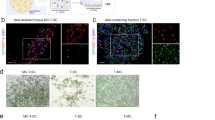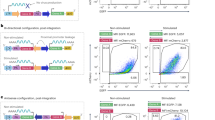Abstract
An important goal of gene therapy is to be able to deliver genes, so that they express in a pattern that recapitulates the expression of an endogenous cellular gene. Although tissue-specific promoters confer selectivity, in a vector-based system, their activity may be too weak to mediate detectable levels in gene-expression studies. We have used a two-step transcriptional amplification system to amplify gene expression from lentiviral vectors using the human insulin promoter. In this system, the human insulin promoter drives expression of a potent synthetic transcription activator (the yeast GAL4 DNA-binding domain fused to the activation domain of the Herpes simplex virus-1 VP16 activator), which in turn activates a GAL4-responsive promoter, driving the enhanced green fluorescent protein reporter gene. Vectors carrying the human insulin promoter did not express in non-β-cell lines, but expressed in murine insulinoma cell lines, indicating that the human insulin promoter was capable of conferring cell specificity of expression. The insulin-amplifiable vector was able to amplify gene expression five to nine times over a standard insulin-promoter vector. In primary human islets, gene expression from the insulin-promoted vectors was coincident with insulin staining. These vectors will be useful in gene-expression studies that require a detectable signal and tissue specificity.
This is a preview of subscription content, access via your institution
Access options
Subscribe to this journal
Receive 12 print issues and online access
$259.00 per year
only $21.58 per issue
Buy this article
- Purchase on Springer Link
- Instant access to full article PDF
Prices may be subject to local taxes which are calculated during checkout








Similar content being viewed by others
References
Hacein-Bey-Abina S, Von Kalle C, Schmidt M, McCormack MP, Wulffraat N, Leboulch P et al. LMO2-associated clonal T cell proliferation in two patients after gene therapy for SCID-X1. Science (New York, NY) 2003; 302: 415–419.
Hacein-Bey-Abina S, von Kalle C, Schmidt M, Le Deist F, Wulffraat N, McIntyre E et al. A serious adverse event after successful gene therapy for X-linked severe combined immunodeficiency. N Engl J Med 2003; 348: 255–256.
Leibowitz G, Beattie GM, Kafri T, Cirulli V, Lopez AD, Hayek A et al. Gene transfer to human pancreatic endocrine cells using viral vectors. Diabetes 1999; 48: 745–753.
Gallichan WS, Kafri T, Krahl T, Verma IM, Sarvetnick N . Lentivirus-mediated transduction of islet grafts with interleukin 4 results in sustained gene expression and protection from insulitis. Hum Gene Ther 1998; 9: 2717–2726.
Ju Q, Edelstein D, Brendel MD, Brandhorst D, Brandhorst H, Bretzel RG et al. Transduction of non-dividing adult human pancreatic beta cells by an integrating lentiviral vector. Diabetologia 1998; 41: 736–739.
Miyoshi H, Blomer U, Takahashi M, Gage FH, Verma IM . Development of a self-inactivating lentivirus vector. J Virol 1998; 72: 8150–8157.
Zufferey R, Dull T, Mandel RJ, Bukovsky A, Quiroz D, Naldini L et al. Self-inactivating lentivirus vector for safe and efficient in vivo gene delivery. J Virol 1998; 72: 9873–9880.
Sadowski I, Ma J, Triezenberg S, Ptashne M . GAL4-VP16 is an unusually potent transcriptional activator. Nature 1988; 335: 563–564.
Emami KH, Carey M . A synergistic increase in potency of a multimerized VP16 transcriptional activation domain. EMBO J 1992; 11: 5005–5012.
Zhang L, Adams JY, Billick E, Ilagan R, Iyer M, Le K et al. Molecular engineering of a two-step transcription amplification (TSTA) system for transgene delivery in prostate cancer. Mol Ther 2002; 5: 223–232.
Sato M, Johnson M, Zhang L, Zhang B, Le K, Gambhir SS et al. Optimization of adenoviral vectors to direct highly amplified prostate-specific expression for imaging and gene therapy. Mol Ther 2003; 8: 726–737.
Iyer M, Salazar FB, Lewis X, Zhang L, Carey M, Wu L et al. Noninvasive imaging of enhanced prostate-specific gene expression using a two-step transcriptional amplification-based lentivirus vector. Mol Ther 2004; 10: 545–552.
Liu BH, Yang Y, Paton JF, Li F, Boulaire J, Kasparov S et al. GAL4-NF-kappaB fusion protein augments transgene expression from neuronal promoters in the rat brain. Mol Ther 2006; 14: 872–882.
Liu B, Paton JF, Kasparov S . Viral vectors based on bidirectional cell-specific mammalian promoters and transcriptional amplification strategy for use in vitro and in vivo. BMC Biotechnol 2008; 8: 49.
Zufferey R, Donello JE, Trono D, Hope TJ . Woodchuck hepatitis virus posttranscriptional regulatory element enhances expression of transgenes delivered by retroviral vectors. J Virol 1999; 73: 2886–2892.
Beattie GM, Lappi DA, Baird A, Hayek A . Functional impact of attachment and purification in the short term culture of human pancreatic islets. J Clin Endocrinol Metab 1991; 73: 93–98.
Odagiri H, Wang J, German MS . Function of the human insulin promoter in primary cultured islet cells. J Biol Chem 1996; 271: 1909–1915.
Segawa T, Takebayashi H, Kakehi Y, Yoshida O, Narumiya S, Kakizuka A . Prostate-specific amplification of expanded polyglutamine expression: a novel approach for cancer gene therapy. Cancer Res 1998; 58: 2282–2287.
Iyer M, Wu L, Carey M, Wang Y, Smallwood A, Gambhir SS . Two-step transcriptional amplification as a method for imaging reporter gene expression using weak promoters. Proc Natl Acad Sci USA 2001; 98: 14595–14600.
Qiao J, Doubrovin M, Sauter BV, Huang Y, Guo ZS, Balatoni J et al. Tumor-specific transcriptional targeting of suicide gene therapy. Gene Therapy 2002; 9: 168–175.
Koster RW, Fraser SE . Tracing transgene expression in living zebrafish embryos. Dev Biol 2001; 233: 329–346.
Iyer M, Salazar FB, Lewis X, Zhang L, Wu L, Carey M et al. Non-invasive imaging of a transgenic mouse model using a prostate-specific two-step transcriptional amplification strategy. Transgenic Res 2005; 14: 47–55.
Kadesch T, Berg P . Effects of the position of the simian virus 40 enhancer on expression of multiple transcription units in a single plasmid. Mol Cell Biol 1986; 6: 2593–2601.
Villemure JF, Savard N, Belmaaza A . Promoter suppression in cultured mammalian cells can be blocked by the chicken beta-globin chromatin insulator 5′HS4 and matrix/scaffold attachment regions. J Mol Biol 2001; 312: 963–974.
Hasegawa K, Nakatsuji N . Insulators prevent transcriptional interference between two promoters in a double gene construct for transgenesis. FEBS Lett 2002; 520: 47–52.
Logan AC, Haas DL, Kafri T, Kohn DB . Integrated self-inactivating lentiviral vectors produce full-length genomic transcripts competent for encapsidation and integration. J Virol 2004; 78: 8421–8436.
Kraunus J, Schaumann DH, Meyer J, Modlich U, Fehse B, Brandenburg G et al. Self-inactivating retroviral vectors with improved RNA processing. Gene Therapy 2004; 11: 1568–1578.
Higashimoto T, Urbinati F, Perumbeti A, Jiang G, Zarzuela A, Chang LJ et al. The woodchuck hepatitis virus post-transcriptional regulatory element reduces readthrough transcription from retroviral vectors. Gene Therapy 2007; 14: 1298–1304.
Wang X, Rosol M, Ge S, Peterson D, McNamara G, Pollack H et al. Dynamic tracking of human hematopoietic stem cell engraftment using in vivo bioluminescence imaging. Blood 2003; 102: 3478–3482.
Zufferey R, Nagy D, Mandel RJ, Naldini L, Trono D . Multiply attenuated lentiviral vector achieves efficient gene delivery in vivo. Nat Biotechnol 1997; 15: 871–875.
Acknowledgements
We thank Denise A Carbonaro-Sarracino for technical assistance with Taqman assays, Ewa Zielinska and Lora Barsky for technical assistance with cell sorting, Karen A Pepper for assistance with molecular assays, and Xingchao Wang for technical assistance with immunohistochemistry assays. We also thank the Cellular Image Core of Childrens Hospital Los Angeles. We acknowledge the use of tissues procured by Islet Cell Resource Centers Basic Science Islet Distribution Program and the National Disease Research Interchange with support from the National Institutes of Health grant 5 U42 RR006042-17. Additional support was provided by awards from the National Institutes of Health: 5F32 AI056894 (KLS), 1R21 DK62649 (DBK), 1RO1 DK68719 (GMC), and from the Juvenile Diabetes Research Foundation: 17-2006-1137 (DBK).
Author information
Authors and Affiliations
Corresponding author
Additional information
Supplementary Information accompanies the paper on Gene Therapy website (http://www.nature.com/gt)
Rights and permissions
About this article
Cite this article
Shaw, K., Pais, E., Ge, S. et al. Lentiviral vectors with amplified β cell-specific gene expression. Gene Ther 16, 998–1008 (2009). https://doi.org/10.1038/gt.2009.49
Received:
Revised:
Accepted:
Published:
Issue Date:
DOI: https://doi.org/10.1038/gt.2009.49
Keywords
This article is cited by
-
Nonmyeloablative Conditioning Regimen to Increase Engraftment of Gene-modified Hematopoietic Stem Cells in Young Rhesus Monkeys
Molecular Therapy (2012)
-
Regulated Expansion of Human Pancreatic β-Cells
Molecular Therapy (2010)



